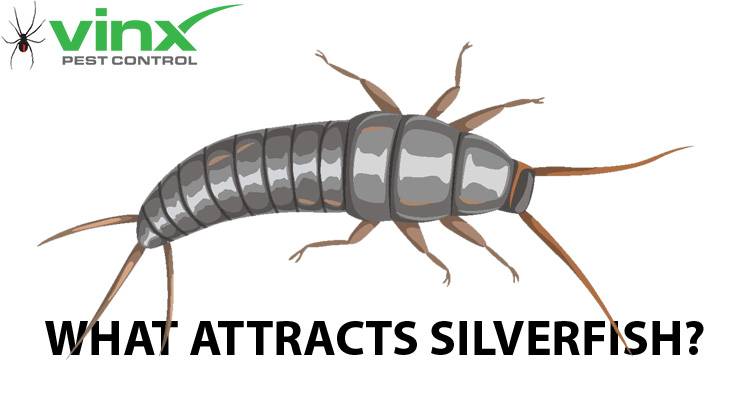Silverfish are tiny insects with a silvery, metallic appearance. People often wonder what attracts silverfish to their homes and how to get rid of them once detected. These pests are attracted to damp, moist, and humid areas. They tend to only come out at night which makes them hard to spot. Since no one wants silverfish in their homes, there are some tried and true tips not only to get rid of them but also prevent them from coming back in the future. If you live in Texas, we serve the entire Dallas area including Denton, Fort Worth, and all the way to Sulphur Springs. We also serve Charleston and Greenville, SC.
What are Silverfish?
Silverfish get their name because their color, movements, and shape resemble that of a fish. When they move, they sway from side to side in a creepy, fishlike rhythm. They belong to the order Thysanura with the scientific name Lepisma saccharina. It also goes by the names fishmoth, bristletail, and paper fish. While they don’t have wings, they are able to move very fast. Adults grow to be about ½-¾”, not including their tail. Their body shape is often compared to a carrot or teardrop, tapering from head to tail.
Silverfish are one of the most prominent pest species in Texas and South Carolina. They prefer to live in most areas with a relative humidity of 75-95%. This love of humidity is why they’re often drawn to basements, attics, bathrooms, and plumbing pipes.
Bugs that look like Silverfish
Because the silverfish bug isn’t that well known, it’s easily confused with a handful of other common bugs. Silverfish grow without metamorphosing. In other words, their body structure doesn’t change as they grow. They reproduce rather slowly and live longer than many other insects. While they certainly have some very distinct traits, they can still be mistaken for a variety of other insects. Here is a list of the bugs that most commonly get mistaken for silverfish:
- Jumping Bristletails
Bristletail is the common name for insects of the order Archaeognatha Zygentoma. This order contains both firebrats and silverfish. These bugs have round bodies, not flat, and have scales, thin bristles, and long antennae. They also lack wings and are more grey in color than silver.
Bristletails are outdoor insects which means there’s a good chance you won’t see them inside your home. And last but not least, jumping bristletails are incredible jumpers, jumping as far as 4 inches when disturbed.
- Firebrats
Although firebrats are darker in color and are brown rather than silver, they still share a striking resemblance to silverfish. They prefer warmer, drier climates than silverfish. While silverfish prefer the moist and damp areas of your home, firebrats are often found near boilers and furnaces for the dry heat they give off.
- Earwigs
To the untrained eye, earwigs can easily be mistaken for silverfish. The biggest difference is that earwigs have two very large pincers trailing behind them. Their dark brown color is also a stark contrast to the distinct metallic shine of the silverfish. The most pronounced similarity between the two is their size. Both earwigs and silverfish measure around ½ inch long.
- Woodlice
When compared side by side, woodlice don’t actually look very much like silverfish. Their gray color and similar sizing are the two factors that cause people to mistake one for the other.
- Centipedes
Most people are somewhat familiar with what a centipede looks like, and in reality, they don’t look all that much like silverfish. But, they’re both extremely fast-moving insects which doesn’t allow you much time to get in a close-up inspection.
Do LED Lights Attract Silverfish?
Many insects are attracted to light. Silverfish are just the opposite. Because they want to stay unnoticed and undetected, they hide from the light. This is unfortunate for us because we can live with them for a long time without noticing their existence.
Do Silverfish Bite?
Even though silverfish may look intimidating, they aren’t known to bite humans and don’t spread disease or sickness. Often mistaken for poisonous centipedes, their creepy appearance is all bark and no bite. But, just because silverfish don’t cause harm to the human body, that doesn’t mean that they don’t cause damage in a different way. Left undetected in
your home, they can destroy the food in your pantry, photographs, clothing, paper, and much more.
Are Silverfish Harmful?
We’ve established that silverfish don’t bite or sting and aren’t harmful to humans. There is one exception to this rule. Humans and pets alike might have an allergic reaction to the byproducts of a silverfish infestation. Their feces, skin molts, and yellow excrement can cause an allergic reaction in rare cases. Also, they feed on items that are high in protein and other starchy materials. They tend to come out at night and wreak havoc on books, clothing, and stored food.
What do Silverfish eat?
Silverfish eat everything from flour and cereal to the glue that binds your books together. As generalist feeders, they are attracted to a very wide range of food sources. Silverfish are typically attracted to items that contain high levels of sugar, protein, and starch. For example, silverfish each your clothes not for the actual material, but for the nourishment found in or on the fabric. Carpets, rugs, fabrics, and paper products can all become a delightful meal for silverfish.
Signs of Silverfish in Your Home
Due to the fact that silverfish are nocturnal and become active at night, they can be difficult to spot. This is a problem because an infestation can be taking place right under your nose, without you suspecting a thing. Here are some signs to watch for that may indicate silverfish in your home:
- Small, yellow stains appearing on your clothing
- Tiny, black pellets around your home
- Feeding marks or damage in the form of holes or notches along the edge of surfaces
- Scales or feces on infested materials
How to get rid of Silverfish
The first step to getting rid of silverfish is to remove from your home the things they are attracted to. Start by depriving them of food. Consider ways to store food in your pantry and cupboards that won’t allow pests to gain access. Be sure all packages are closed with ties and store dry goods such as sugar, flour, or cereal in containers with sealed lids.
Next, consider other more unconventional food sources in your home. While silverfish won’t go for these first, that doesn’t mean they eventually won’t. Sprinkle the path toward these areas with your choice of insect repellents or even essential oils.
Finally, take time to deep clean your home. It doesn’t have to be spotless, but a thorough dusting, sweeping, and vacuuming will eliminate any extra sources of food. Be sure to address areas in your home such as your attic, basement, closets, or other unused rooms as well.
Remember that silverfish are drawn to damp, moist areas of your home. A silverfish infestation is often a sign of excessive dampness in parts of your home. If you don’t treat the factors that caused your silverfish problem, they will return time and time again.
What Attracts Silverfish Conclusion
Even after all your efforts to remove food and water sources and giving your home a thorough cleaning, silverfish may linger. These pests are hearty and won’t go without a fight. If you’re tired of dealing with unwanted insects in your home, give Vinx Pest Control a call. Hiring an expert to handle your silverfish infestation is often the best choice.
The professionals have years of experience and knowledge dealing with these pests and will be able to efficiently solve your problem. In South Carolina, we have locations serving Simpsonville, Greer, and Spartanburg in the Greenville area. We also serve the entire Charleston area including North Charleston and Mount Pleasant.




